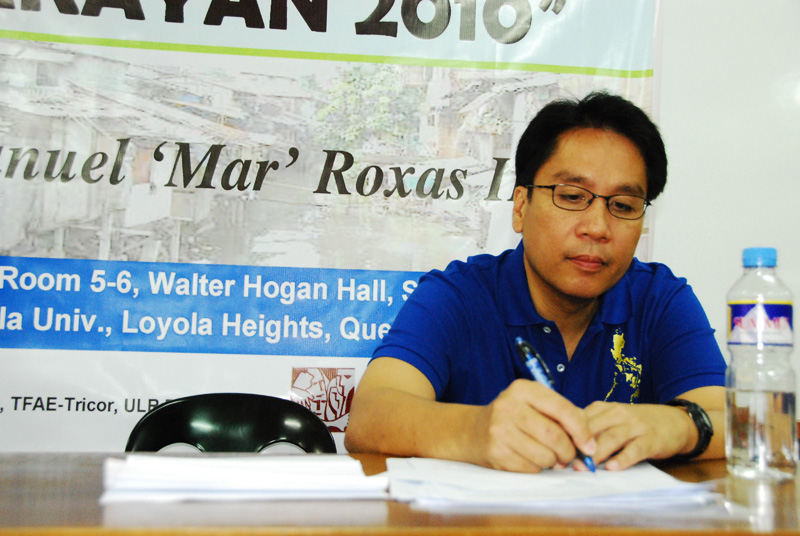
May 3, 2016, by Editor
A Family Business: The Rise & Fall of the Roxas Dynasty
Written by Elliot Newbold
With little under a week to go until the Philippine presidential elections, the stage is set for something of a political upset. Currently, the outlandish mayor of Davao City, Rodrigo “Digong” Duterte, holds the lead as the candidate most likely to succeed Benigno “Noynoy” Aquino III at Malacañang Palace. Despite brazenly deleterious comments that have drawn international condemnation, Duterte still looks set to upturn the established political order.
It is no secret that Filipino politics is driven by personality over political platforms. Indeed, one of the most discernible reasons for Duterte’s meteoric rise is his anti-establishment tone; he’s promised to fight crime, tackle corruption, and challenge inequality, all whilst providing a fresh-faced alternative to the dynastic political elite that dominate Filipino politics. Clearly, Duterte’s populism has captivated the electorate. Yet, the question remains: what happens to the old-guard if, and when they’re driven out of power?
The Roxas Dynasty
In attempting to answer this question, it is interesting to focus on the supposed successor to the presidency, Manuel “Mar” Roxas II. A former investment banker, Roxas’ career in Philippine politics has been one of continual ascendance. Entering Congress in 1993, his rise in stature continued virtually unabated until 2009, when he opted to step down as a presidential candidate for the 2010 elections in favour of his friend and ally, Noynoy Aquino. Since then, Roxas has cemented his presidential credentials by serving in the Aquino cabinet and shoring up support amongst influential allies. As the standard-bearer of the ruling Liberal Party, Roxas has been endorsed by Aquino and his administration as the preferred successor to the presidency. Yet, from the outset of the election, Roxas has failed to gain traction with the electorate. At the time of writing, Roxas stands in third place at the polls with as little as 17% of voters supporting his candidacy.
Why is it that Roxas has failed to gather purchase on the presidential race? One explanation highlights his family’s legacy as part of the established political elite. Roxas encapsulates what Dante Simbulan has called the “modern principalia;” a dynastic and oligarchic form of political control in which power is located within a small section of wealthy landowners and political heavyweights. As the scion of a wealthy and influential family, Roxas is the embodiment of elitism in Filipino political culture. His grandfather, Manuel Roxas I, served as the first president of the independent Philippine republic from 1946 to 1948. His troubled tenure as president was characterised by flagrant corruption and questionable political practices. After the elder Roxas’ tenure as president, the familial dynasty continued to develop. Mar’s father, Gerado “Gerry” Roxas, was a prominent congressman during the 1950s and 1960s. Heading the party his own father helped create, Gerry served as a Liberal senator from 1963 until the imposition of martial law by Ferdinand Marcos in 1972. Of Gerry’s two sons, Mar and Gerado “Dinggoy” Jr., the latter would become the successor to the Roxas legacy. Elected in 1987 in the wake of the EDSA revolution that ousted Ferdinand and his wife Imelda from power, Dinggoy served as a Liberal congressman until his death in 1993. Upon the passing of his brother, Mar returned from working in the United States to take up the familial mantle as a Liberal Party politician.
An Elite Image
During his announcement for the 2016 presidential bid, Roxas reflected on his family’s position at the head of the Philippine’s socio-political strata, “when Dinggoy died, the responsibility of living up to the principles of my family was put on me. I could not turn my back on this; I could not turn my back on the memory of my Dad, of Dinggoy.” Whilst Roxas’ own attitude to his family’s political legacy appears sentimental, critics of the establishment figure cite such connections as another example of his elitist image. Perceived as out of touch by many of the Filipino electorate, Roxas has compounded his image as an “artificial” and “fake” politician through a number of PR blunders. In the wake of Typhoon Yolanda in November of 2013, he was caught on tape telling Tacloban Mayor, Alfred Romualdez (nephew of Imelda and cousin to Marcos’ son, Ferdinand “Bong Bong” Jr., himself a leading candidate for the vice presidency) that “you are a Romualdez, and the President is an Aquino.” More recently, allegations of vote-buying against Roxas and his party made headlines as a video posted on social media showed a Liberal Party campaigner telling audience members to cheer for Roxas so they would receive “envelopes.” Meanwhile a comic book (distributed during a campaign sortie in Cavite) which pictured Roxas as a heroic figure during Typhoon Yolanda drew scorn from his critics. Dynastic grandstanding and allegations of corruption weigh heavy on the minds of many Filipinos. Such scandals and antics have done much to perpetuate an image of Roxas epitomised by graft and elitism.
End of the Establishment?
The Roxas dynasty is one of many powerful clans that exercise sustained influence over the Philippine political system and its democratic processes. Yet, the rise of Duterte as an anti-establishment candidate demonstrates voter frustration with established elites. Roxas, the poster-boy for establishment politics, has failed to gather pace as a presidential candidate partly because of this association with the upper echelons of Filipino society. Regardless of the outcome on May 9th, this dangerous association with dynastic politics will continue to hamper the Philippines’ political development until more is done to challenge the status-quo.
Elliot Newbold is a postgraduate researcher in the University of Nottingham’s American & Canadian Studies Department. His research focuses on American perceptions of Philippine independence. This article forms part of IAPS continuing coverage of the 2016 general election in the Philippines. Image credit: CC by The Philippine Online Chronicle/Flickr.
No comments yet, fill out a comment to be the first

Leave a Reply